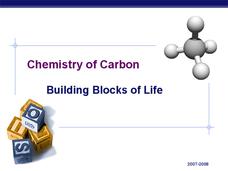Curated OER
Milk Makes Me Sick
High schoolers experiment with lactase to find out how milk sugar is broken down in the body. In this enzyme lesson, students use glucose strips to investigate the breakdown of lactose into glucose and galactose for milk digestion in the...
Curated OER
Chemistry Worksheet 14
In this chemistry worksheet, students sketch several diagrams of different peptide chains. Students sketch diagrams of galactose and fructose.
Curated OER
Biologically Important Molecules
In this biologically important molecules worksheet, students fill in the blank with information about carbohydrates, lipids, and proteins. Students also make notes about nucleic acids.
Curated OER
The Four Groups of Biologically Important Compounds
This is not they typical set of teacher instructions. It is an organized chart of the important organic compounds. For each, the involved elements, the name of the building block monomers, the names of polymers, extra information, and a...
Curated OER
Chemistry of Carbon - Building Blocks of Life
A great review of the structure and function of carbon-based molecules important to life, especially with relevance to humans. The chemistry behind the combination of polymers and the breakdown of bonds is covered. Valuable content in...
Curated OER
Enzymes Help Us Digest Food ~ Introduction to Sugars and Enzymes
After an explanatory introduction to sugars and enzyme activity, biochemists discover whether lactase is needed to digest lactose, sucrose, and milk as a whole. High school science lab skills are required for these investigations.
Curated OER
Chemistry 116 Exam 2 Summer 2009
Written for an introductory organic and biochemistry course, this exam will challenge your class. They label functional groups and stereocenters on drawings of molecules, draw structures given the name, complete drawings of chemical...
Curated OER
Cellular Respiration: Other Metabolites and Control of Respiration
The feedback mechanisms of metabolism of a variety of substances in the human body. Carbohydrates, lipids, amino acids, and their derivatives are explained. The biochemistry required to explain the metabolic balance and feedback controls...
Curated OER
Organic Compounds
For this organic compounds worksheet, students practice identifying chemical structures and compare sugars, starches, and lipids. This worksheet has 5 matching and 15 multiple choice questions.
Curated OER
Lactose & Lactase
Students examine the characteristics of lactose and lactase. In this enzyme lesson plan students study the lactose in milk and its rate of dissolution.
Curated OER
Biological Reactions
In this biological reactions activity, students identify the type of biological reaction with the given example. Students also re-draw the biological reactions and circle the atoms that react together.
Curated OER
Biochemistry Quiz
In this biochemistry instructional activity, learners review amino acids, proteins, lipids, and carbohydrates. This instructional activity has 29 multiple choice, 8 fill in the blank, and 3 short answer questions.
Curated OER
ECOLOGICAL BIOASSAY OF COPPER SULFATE IN DAPHNIA MAGNA
Students use this lab as a follow up to the introduction of the ecosystems and productivity levels, bioassays and what and how they measure, and Daphnia magna as an index organism, i.e., a species whose health within an ecosystem...
Curated OER
Carbohydrate Functionality - Sweeteners
In this carbohydrate activity, students conduct three experiments to determine the function of sweeteners. This activity has 3 short answer questions.















